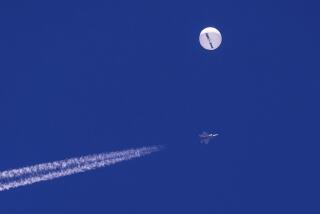Giant Cosmic Snowballs Adding Water to the Earth’s Oceans
- Share via
Giant cosmic snowballs are bombarding the upper atmosphere, then breaking up, adding water to Earth’s oceans and possibly nurturing life on the planet, according to new results from NASA’s Polar spacecraft. The snowballs are actually small comets about 40 feet in diameter, and appear to be streaking toward Earth in a steady stream. But the snowballs are no danger to people on Earth or to astronauts, spacecraft or airplanes because they break up at such high altitudes--from 600 to 15,000 miles.
At that altitude, the snowballs break up into fragments. Then exposure to sunlight vaporizes the fragments into vast clouds, which are in turn dispersed by winds. Between five and 30 such comets strike each moment, according to University of Iowa astronomer Louis A. Frank, who on Wednesday presented photographs of the 10- to 20-ton objects streaking toward the Earth to scientists at the spring meeting of the American Geophysical Union in Baltimore.
If they have been falling since the formation of the solar system, he said, the snowballs could explain how Earth’s oceans were formed. They may also figure into scientists’ thinking about water and life on Mars, as well as water and ice on Earth’s moon and on several moons of Jupiter.
“The implications of this, if true, are enormous,” Frank said as he presented new evidence for his once-ridiculed theory.
“This relatively gentle cosmic rain--which possibly contains organic compounds--may well have nurtured the development of life on our planet,” Frank said. The new evidence resurrects a theory widely rejected as preposterous when Frank first proposed it in 1986: that a strange population of stealthy, relatively small comets made of almost pure ice has been spraying water into Earth’s upper atmosphere at a sufficiently high rate over the 4.5-billion-year life of the planet to have created all the oceans.
This week, several of Frank’s leading former critics said the new evidence appears solid.
However, some scientists remained only partly persuaded Wednesday. Several, including retired NASA geophysicist Maurice Dubin, questioned Frank’s assertions about the mass and composition of the objects, and his ideas about how they remain intact in interplanetary space.
Frank invited his audience to investigate his claims, and forgave them their earlier doubts. “I don’t blame people for the criticism, but they cannot criticize these results,” he said.
Frank and University of Iowa researcher Dr. John Sigwarth spent 10 years developing cameras capable of resolving the doubts. The cameras were launched last year aboard NASA’s Polar satellite.
Their mission is the study of Earth’s electrical and magnetic environment, including auroral displays near the poles.





